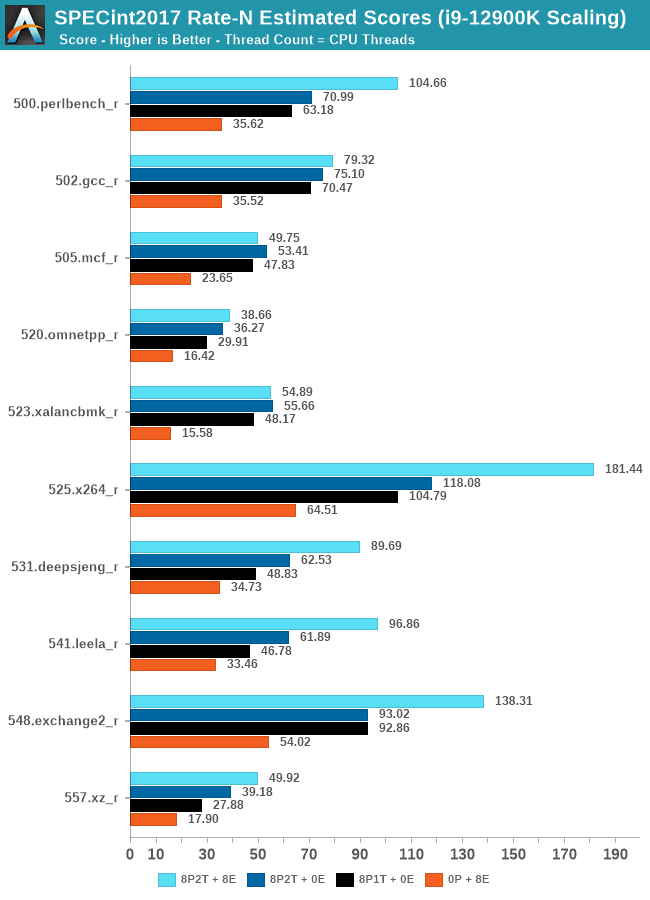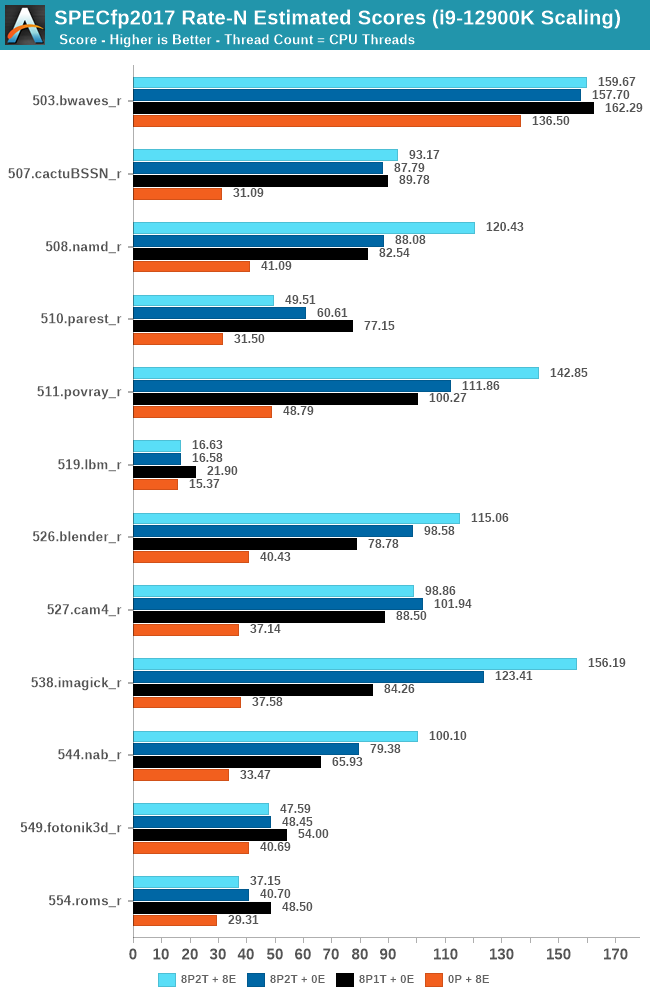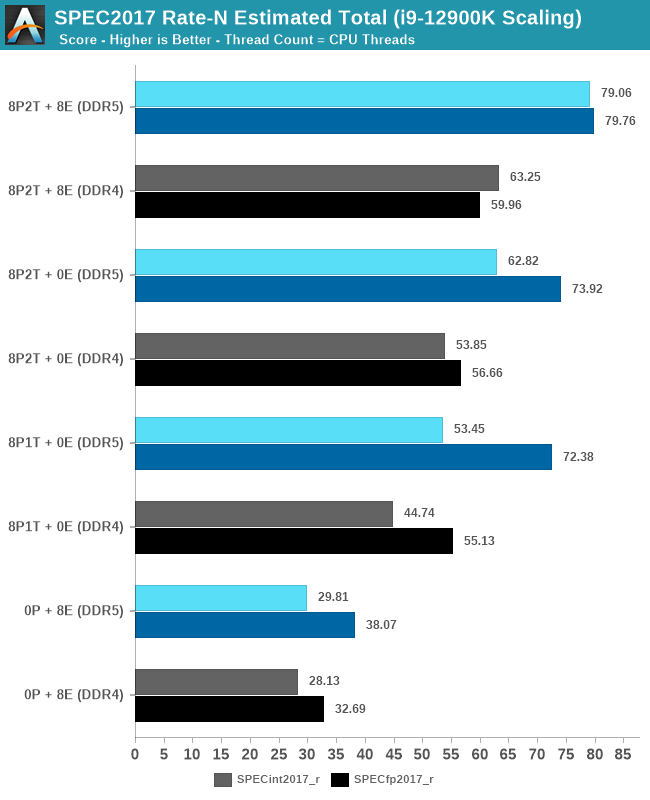The Intel 12th Gen Core i9-12900K Review: Hybrid Performance Brings Hybrid Complexity
by Dr. Ian Cutress & Andrei Frumusanu on November 4, 2021 9:00 AM ESTCPU Tests: SPEC MT Performance - P and E-Core Scaling
Update Nov 6th:
We’ve finished our MT breakdown for the platform, investigating the various combination of cores and memory configurations for Alder Lake and the i9-12900K. We're posting the detailed scores for the DDR5 results, following up the aggregate results for DDR4 as well.
The results here solely cover the i9-12900K and various combinations of MT performance, such as 8 E-cores, 8 P-cores with 1T as well as 2T, and the full 24T 8P2T+8E scenario. The results here were done on Linux due to easier way to set affinities to the various cores, and they’re not completely comparable to the WSL results on the previous page, however should be within small margins of error for most tests.

In the integer suite, the E-cores are quite powerful, reaching scores of around 50% of the 8P2T results, or more.
Many of the more core-bound workloads appear to very much enjoy just having more cores added to the suite, and these are also the workloads that have the largest gains in terms of gaining performance when we add 8 E-cores on top of the 8P2T results.
Workloads that are more cache-heavy, or rely on memory bandwidth, both shared resources on the chip, don’t scale too well at the top-end of things when adding the 8 E-cores. Most surprising to me was the 502.gcc_r result which barely saw any improvement with the added 8 E-cores.
More memory-bound workloads such as 520.omnetpp or 505.mcf are not surprising to see them not scale with the added E-cores – mcf even seeing a performance regression as the added cores mean more memory contention on the L3 and memory controllers.

In the FP suite, the E-cores more clearly showcase a lower % of performance relative to the P-cores, and this makes sense given their design. Only few more compute-bound tests, such as 508.namd, 511.povray, or 538.imagick see larger contributions of the E-cores when they’re added in on top of the P-cores.
The FP suite also has a lot more memory-hungry workload. When it comes to DRAM bandwidth, having either E-cores or P-cores doesn’t matter much for the workload, as it’s the memory which is bottlenecked. Here, the E-cores are able to achieve extremely large performance figures compared to the P-cores. 503.bwaves and 519.lbm for example are pure DRAM bandwidth limited, and using the E-cores in MT scenarios allows for similar performance to the P-cores, however at only 35-40W package power, versus 110-125W for the P-cores result set.
Some of these workloads also see regressions in performance when adding in more cores or threads, as it just means more memory traffic contention on the chip, such as seen in the 8P2T+8E, 8P2T regressions over the 8P1T results.

What’s most interesting here is the scaling of performance and the attribution between the P-cores and the E-cores. Focusing on the DDR5 set, the 8 E-cores are able to provide around 52-55% of the performance of 8 P-cores without SMT, and 47-51% of the P-cores with SMT. At first glance this could be argued that the 8P+8E setup can be somewhat similar to a 12P setup in MT performance, however the combined performance of both clusters only raises the MT scores by respectively 25% in the integer suite, and 5% in the FP suite, as we are hitting near package power limits with just 8P2T, and there’s diminishing returns on performance given the shared L3. What the E-cores do seem to allow the system is to allows to reduce every-day average power usage and increase the efficiency of the socket, as less P-cores need to be active at any one time.










474 Comments
View All Comments
Spunjji - Friday, November 5, 2021 - link
This. People often get halfway through the analogy and then give up when they think it's made their argument for them.Dribble - Sunday, November 7, 2021 - link
The having lots of potential power and high power consuption is exactly what mobile phones and laptop cpu's do. That Intel do that in desktops too is not surprising.Spunjji - Friday, November 5, 2021 - link
99% of users don't need a 12900K. Presumably the people who do are likely to use it for these tasks where it will actually show a performance improvement over a cheaper CPU (accepting that some people overspend for e-peen reasons and will buy one for gaming where a 12600K would do just as well).lmcd - Friday, November 5, 2021 - link
99.9999999999% of users don't need a 12900K peak performance constantly, even if they will use the peak performance sometimes, including times when it definitely counts.I won't lie and say I have the best of the best, but Zen 2 vs Zen 1 cut down my build times noticeably. That helps keep me in flow, even if it's only saving me a few minutes per day. For people like me with ADHD or other attention-related issues, this can be a massive boon.
brucethemoose - Thursday, November 4, 2021 - link
Does efficiency really matter for top end desktop SKUs? Intel/AMD tend to clock these near their voltage walls, WAY outside the "sweet spot" of a given architecture, and you can get a boatload of efficiency back just dropping boost clocks by 10% yourself.Now, if the laptop SKUs end up being power hungry, thats a different story.
Blastdoor - Thursday, November 4, 2021 - link
Same core design, same process. So.... I'm sure Intel will lower clocks for mobile and servers to get power usage down, but once they lower the clocks, how will the performance compare?meacupla - Thursday, November 4, 2021 - link
For now, efficiency doesn't matter for desktops, but in a few years time, we are very likely to see laws passed that will mandate high efficiency in high end desktops.There are already some legislation in the works that calls for exactly this, but have not been passed yet.
TheinsanegamerN - Thursday, November 4, 2021 - link
And how, pray tell, are they going to legislate that? Max power usage for a CPU? We've already seen how california tried it, and predictably they made a mess of it.INB4 intel just refuses to sell anything but a celeront o californians and mysteriously tech resellers in arizona get a bunch of cali orders. Hmmmm.....
meacupla - Thursday, November 4, 2021 - link
don't ask me, IDK how law makers will do it. Just be aware that there are some really dumb laws that are already in existence, and the world is going to be entering an age of power shortages, along with carbon neutral incentives.Considering how things are going currently, I think it'll just be a 100% tax on desktop CPUs that can't hit some efficiency metric that Apple has designed.
Wrs - Thursday, November 4, 2021 - link
Doubtful given how poorly the existing law works. All they do is measure computer idle wattage. The lawmakers aren't techies. And they're busy handling the blowback from carbon neutrality bills that the pubic believes are related to power shortages and cost spikes.